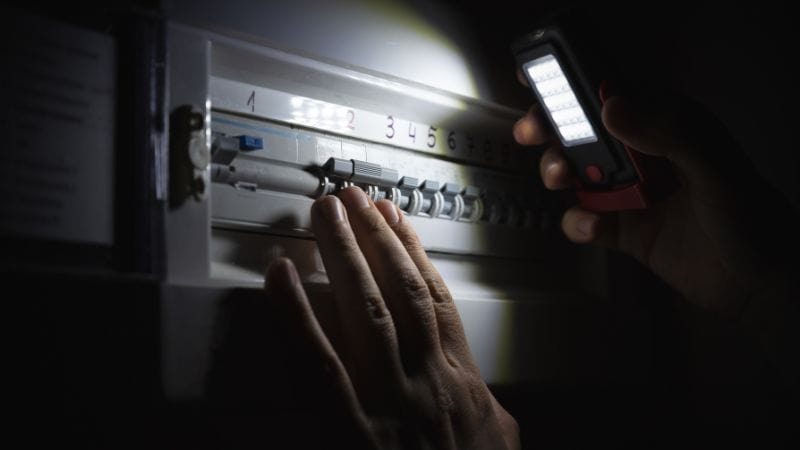
Power outages happen when the flow of electricity to your home or business is interrupted. The most common cause of power outages is severe weather, such as storms, high winds, or lightning, which can damage power lines and equipment. Other factors like accidents, fallen trees, wildfires, animals, or even equipment failure can also stop the power.
You might think the power plant is often to blame, but usually, the problem occurs in the local electrical grid near you. Sometimes outages are planned to keep you safe during extreme conditions or to prevent bigger issues in the system. Understanding what causes outages can help you be better prepared when your power goes out.
Different Types of Power Outages
Power outages come in different forms, each with its own cause and duration. Knowing the type can help you understand what is happening and how to respond.
Blackouts are complete losses of power in a large area. They can last from minutes to hours and often happen due to major faults in the transmission or distribution systems. You might experience a blackout during severe weather or equipment failure.
Brownouts happen when the power supply drops below normal voltage. This causes lights to dim and appliances to work poorly. Brownouts are often used by utilities to reduce strain on the grid during high demand.
Momentary Outages are very short interruptions, usually lasting just a second or two. These occur because of quick faults in power lines or switching operations and often fix themselves automatically.
Here is a simple overview:
| Type | Description | Duration | Common Cause |
|---|---|---|---|
| Blackout | Total loss of power | Minutes to hours | Storms, equipment failure |
| Brownout | Drop in voltage | Minutes to hours | High demand, grid stress |
| Momentary Outage | Very brief interruption | Seconds | Faults, switching actions |
Understanding these types helps you prepare better when the power goes out. You’ll know if the problem is temporary or might last longer.
Common Causes of Power Outages
Power outages happen for many reasons, often involving damage to power lines, equipment, or sudden changes in electricity demand. Understanding these causes can help you prepare for and respond to outages more effectively.
Severe Weather (Most Common Cause)
Storms and severe weather conditions are the top reason for power outages. High winds, heavy rain, lightning, and ice can all damage power lines and equipment.
When storms hit, you might see downed power lines, often caused by wind or heavy ice weighing them down. Lightning strikes may cause power surges, which can trip circuits or fry electrical parts. Flooding can also damage underground power lines, affecting your electricity supply.
Severe weather often disrupts large areas, sometimes leaving thousands of people without power for hours or days.
Trees and Vegetation
Trees and branches near power lines are a major risk. During storms or heavy winds, branches can break and fall onto power lines, causing them to snap or short-circuit. Even without storms, growing trees can touch wires and cause faults.
Electric companies often trim trees to reduce this risk, but unexpected growth or missed areas may still cause power outages. You should never try to cut branches near power lines yourself because it’s dangerous.
Keeping vegetation away from power lines helps reduce the chance of an outage caused by plants.
Wildfire Risk
Wildfires are an increasingly common and destructive cause of power outages. Intense heat and flames can directly melt power lines and destroy utility poles and electrical infrastructure.
To prevent their equipment from sparking new fires, especially during dry, windy “red flag” conditions, utility companies may proactively shut off power to high-risk areas. These planned Public Safety Power Shutoffs (PSPS) can leave communities without electricity for extended periods to ensure overall community safety.
The damage from a major wildfire can be so extensive that it requires a complete rebuild of the electrical grid in affected areas, leading to prolonged outages.
Wildlife Interference
Animals like squirrels, birds, and snakes can accidentally cause power disruptions. When creatures come into contact with electrical equipment or power lines, they might create short circuits or damage components.
This is more common on overhead lines and at transformer stations. Though outages from wildlife usually affect smaller areas, they can still happen at any time and cause inconvenient or costly interruptions.
Utilities use barriers and devices to reduce these incidents, but wildlife remains a natural and unpredictable cause.
Equipment Failures
Power grids depend on many machines and devices, such as transformers and circuit breakers. When parts wear out, overheat, or fail, they can interrupt electricity flow.
Technical problems like a blown fuse, broken insulator, or transformer failure quickly cause a power outage in your area. Equipment failures happen both above ground and with underground power lines.
Proper maintenance lowers the chance of failure, but aging infrastructure or unexpected faults still lead to outages. You may notice flickering lights or total loss of power during these events.
Human Accidents
Sometimes, people cause outages by mistake. Construction work hitting a power pole or power line can cut electricity to homes and businesses quickly. Vehicle crashes into poles also disrupt power. Even digging without checking for buried cables can break underground power lines.
Human error can cause outages that affect small neighborhoods or larger areas depending on the location.
High Power Demand
Electric systems are designed for a specific maximum load. When many people use electricity at once—like during heatwaves with lots of air conditioning—demand can exceed supply. This can cause brownouts or outages as power companies reduce service to prevent damage to the grid.
You may experience outages when the electrical grid is overwhelmed, especially in regions with aging systems or limited capacity.
Cyber-attacks
Hackers can target power grids to disrupt service. Cyber-attacks can disable control systems or damage key equipment remotely.
While less common, these attacks can cause widespread outages and pose risks to critical infrastructure. Utilities invest heavily in cybersecurity and constantly monitor and defend cyber threats to protect you and your community.
Power Outage Solutions: Reliable Generators from Gretechpower
While power outages are often beyond our control, being left in the dark doesn’t have to be. That’s where Gretechpower comes in. Our range of premium generators is specifically designed to provide a seamless and reliable solution. We provide the peace of mind that comes from knowing your power, safety, and comfort are protected. Here are some of our company’s best-selling generators:
1. Natural Gas, Petrol/LPG Powered Generator for Home
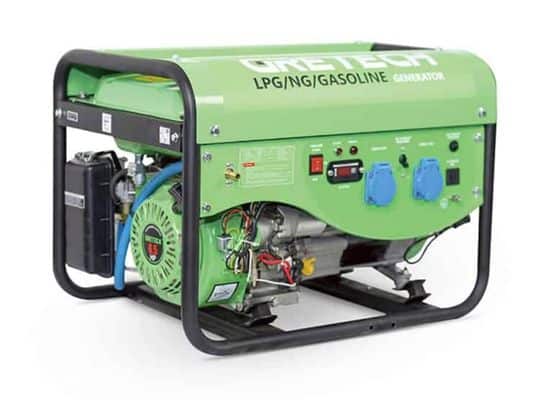
(Click on the image for more info.)
Main Advantages:
- Offers dual fuel options (LPG and Petrol) and compatibility with Natural Gas, catering to diverse user needs.
- Competitive fuel consumption rates provide reliable power while minimizing costs.
- Electric and recoil start options ensure easy operation, enhancing user convenience.
- Equipped with an Automatic Voltage Regulator (AVR), low oil alert, and circuit breaker for enhanced safety and stable power output.
- Lightweight design (46kg) with optional wheels and handles facilitates easy transport.
- Operates at 68 dB(A), providing a more peaceful environment during use.
- CE certification guarantees adherence to EU5 noise and emissions standards, ensuring environmental safety.
This generator is an ideal choice for those seeking a reliable power source for home use, combining efficiency, flexibility, and user-friendliness. Perfect for distributors looking to add robust LPG powered solutions to their portfolio.
2. Silent Gas Generator, LPG/NG
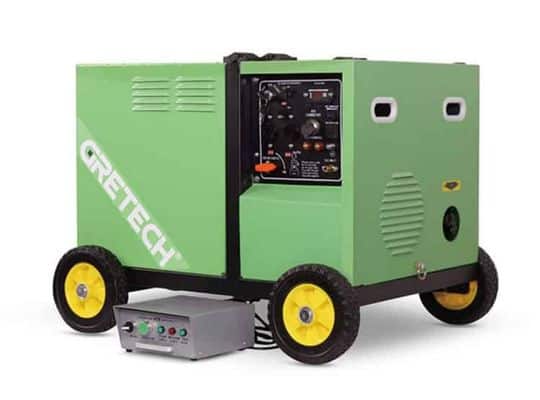
(Click on the image for more info.)
Main Advantages:
- Versatile operation on LPG and natural gas enhances flexibility.
- High power output ensures efficient performance for various applications.
- Durable engine design provides long-lasting reliability.
- Low noise level minimizes disturbance during operation.
- Built-in safety features enhance user protection.
- Compact design allows for easy transportation and installation.
The Silent Gas Generator is an ideal choice for distributors looking for a reliable and efficient power solution that minimizes noise without compromising on performance.
3. Inverter Generator with 12V Output, Hybrid, LPG/ NG/ Petrol
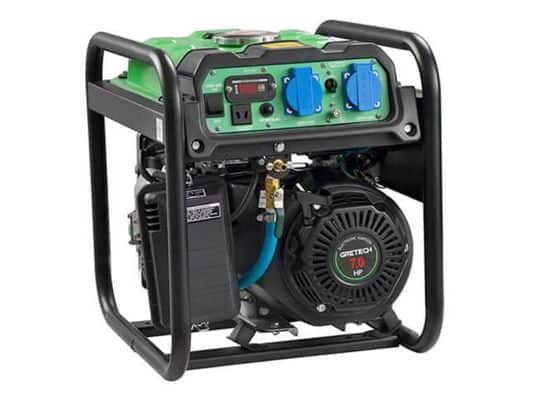
(Click on the image for more info.)
Main Advantages:
- Compatible with petrol, LPG, and natural gas for versatile use.
- Lightweight at 25.5 kg for easy transport and storage.
- Delivers up to 4000W, suitable for various devices.
- Low fuel consumption for cost efficiency.
- Features a simple recoil start and a 7.5L fuel tank for longer operation.
- Operates quietly at 68 dB for minimal noise.
- Includes a low oil alert system for engine protection.
- Complies with CE, EU5, and noise regulations for safety and reliability.
This generator with 12V output is an essential tool for anyone seeking a reliable, portable power solution that adapts to their fuel preferences and power needs.
4. Welding Gasoline Powered Portable Generator
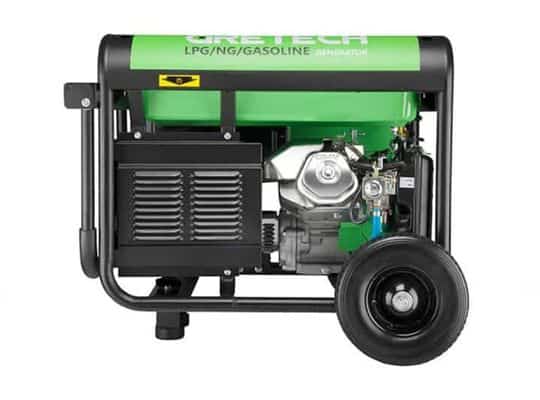
(Click on the image for more info.)
Main Advantages:
- Easy integration with single-phase operation
- Durable construction with copper wire for longevity
- User-friendly recoil start system
- Operates at 220V and 50Hz with AVR for stable output
- Safety features include low oil alert and circuit breaker
- Fuel-efficient at 0.58L per kW.h at 75% capacity
- Powered by a robust 15HP, 439cc 4-stroke engine
- Portable with a 25L fuel tank for extended use
- Operates quietly at 70dB(A)
- Compliant with CE and EU5 standards for quality and safety
This Welding Gasoline Powered Portable Generator merges power generation and welding capabilities, appealing to a wide market segment and enhancing distributor offerings in the equipment sector.
FAQs
What are the predominant factors leading to power interruptions?
The main causes include severe weather, equipment failure, and damage to power lines. Sometimes human error or cyberattacks can also disrupt service.
How do storms contribute to electricity supply disruptions?
Storms like thunderstorms, hurricanes, and snowstorms can break power lines or damage transformers. Wind and heavy rain can knock down trees that fall on electrical equipment.
What can provoke a loss of electrical service in residential areas?
Fallen trees, damaged transformers, and broken underground cables often cause outages in neighborhoods. Equipment problems inside homes can also look like an outage but may be local issues.
What infrastructure issues result in widespread electric outages?
Failures in the bulk power system or substations can cut power over large areas. Aging equipment and lack of maintenance increase the risk of these large-scale outages.
In what ways do wildlife interactions lead to power supply failures?
Animals like squirrels or birds can touch electrical equipment and cause short circuits. This can trip breakers or damage parts, leading to outages.
